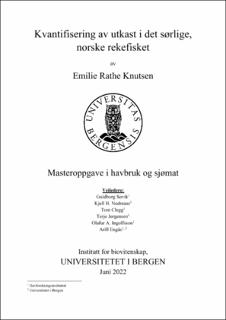| dc.contributor.author | Knutsen, Emilie Rathe | |
| dc.date.accessioned | 2022-06-25T00:24:40Z | |
| dc.date.available | 2022-06-25T00:24:40Z | |
| dc.date.issued | 2022-06-01 | |
| dc.date.submitted | 2022-06-17T22:04:48Z | |
| dc.identifier.uri | https://hdl.handle.net/11250/3000811 | |
| dc.description.abstract | Utkast i fiskerier fører til at verdifulle ressurser går til spille og urapportert utkast kan føre til en økt usikkerhet ved bestandsvurderinger. Det estimeres at omtrent 10 % av global fangst kastes ut, og det er varierende overlevelsesevne mellom arter ved utkast. Reketrål forbindes ofte med store mengder bifangst, og følgelig antas det også at det er store mengder utkast i rekefiskeriet. Det sørlige norske rekefisket drives hovedsakelig i Norskerenna og Skagerrak, og til tross for at det er et utkastforbud for de aller fleste kommersielle fiske- og krepsdyrartene i norske farvann forekommer det likevel urapportert utkast i fiskeriet. Utkast i det norske rekefisket i statistisk område 08 ble estimert ved bruk av data innsamlet fra Kystreferanseflåten (KRF), et utvalg kommersielle reketrålere som samarbeider med Havforskningsinstituttet om rapportering av fangst. Antall registrerte sluttsedler fra den offisielle, norske landingsstatistikken ble brukt til å oppskalere estimert mengde utkast av en rekke arter til hele reketrålflåten i området. Denne studien viser at estimert utkast utgjorde av en andel på 4-26 % av totale fangster per kvartal i perioden 2019-2020. Øyepål, piggskate, kolmule og rognkjeks var de artene som ble kastet ut i høyest kvantum, hvor alle artene er arter som ikke utnyttes til konsumformål. Det ble estimert lave mengder utkast av konsumfisk, hvor hovedårsaken til utkast av disse artene antas å være at individene var under minstemål. Estimert mengde utkast av dypvannsreke var i denne studien lavere enn estimerte mengder utkast for tidligere år, og det var høyere utkast i 2019 enn i 2020. Lengdefordelinger av dypvannsreke viste at det forekommer utkast av lengder over minstemål, men det antas likevel at high grading ikke forekommer i stor grad. Denne studien bygger på forutsetningen om at data innsamlet av KRF er representative for hele flåten. Til tross for at det er forsøkt å avgjøre representativitet i denne studien, anbefales det videre arbeid for å undersøke om forutsetningen stemmer. Fremtidige forbedringer av både datainnsamling, representativitet og estimering av utkast anbefales, og det foreslås forslag til forbedringer. | |
| dc.description.abstract | Discards in fisheries lead to a waste of valuable resources and unreported discards can lead to increased uncertainty in stock assessments. It is estimated that around 10 % of global catches are discarded, and the survival rate when discarded varies between species. Shrimp trawls are often associated with large quantities of by-catch, and consequently it is also assumed that there are large quantities of discards in the shrimp fishery. The southern Norwegian shrimp fishery is operated mainly in the Norwegian Deep and Skagerrak, and despite the fact that there is a discard ban for the vast majority of commercial fish and crustacean species in Norwegian waters, there are still unreported discards in the fishery. Discards in the Norwegian shrimp fishery in statistical area 08 were estimated using data collected from the Coastal Reference Fleet (CRF), a selection of commercial shrimp trawlers that collaborate with the Institute of Marine Research on reporting catches. The number of registered sales notes from official Norwegian landing statistics were used to upscale the estimated discard for several species to fit the entire shrimp trawl fleet in the area. This study shows that the estimated discard accounted for 4-26 % of total catches per quarter in the period 2019-2020. Norway pout, Thornback ray, Blue whiting and Lumpsucker were the species that were discarded in the highest quantity, all of which are species that are not utilized for human consumption. Low amounts of discards of commercial species were estimated, and the main reason for discards of these species was assumed to be that the individuals were below the minimum fishing size. The estimated discard of Northern shrimp in this study was lower than estimated amounts of discard in previous years, and the estimated discard was higher in 2019 than in 2020. Length distributions of Northern shrimp indicated that discard of lengths above the minimum fishing size occurred, although it is still assumed that high grading does not frequently occur. This study relies on the assumption that the data collected by CRF was representative for the entire fleet in the area. Despite attempts to determine representativeness in this study, further work is recommended to investigate whether the assumption is correct. Future improvements of both data collection, representativeness and estimations of discard are recommended, and suggestions for improvements are proposed. | |
| dc.language.iso | nob | |
| dc.publisher | The University of Bergen | |
| dc.rights | Copyright the Author. All rights reserved | |
| dc.title | Kvantifisering av utkast i det sørlige, norske rekefisket | |
| dc.title.alternative | Quantification of discards in the southern Norwegian shrimp fishery | |
| dc.type | Master thesis | |
| dc.date.updated | 2022-06-17T22:04:48Z | |
| dc.rights.holder | Copyright the Author. All rights reserved | |
| dc.description.degree | Masteroppgave i biologi | |
| dc.description.localcode | BIO399 | |
| dc.description.localcode | MAMN-HAVSJ | |
| dc.description.localcode | MAMN-BIO | |
| dc.subject.nus | 751999 | |
| fs.subjectcode | BIO399 | |
| fs.unitcode | 12-60-0 | |
